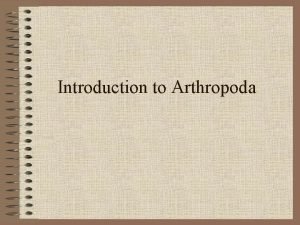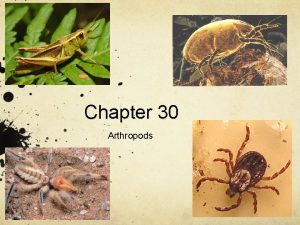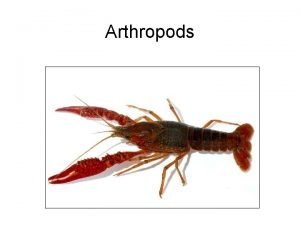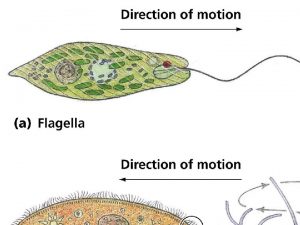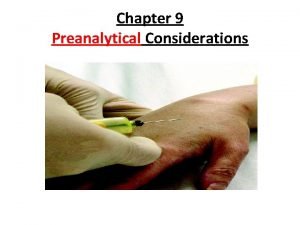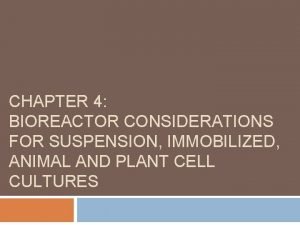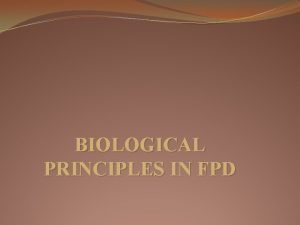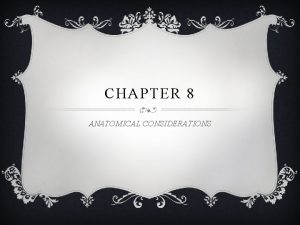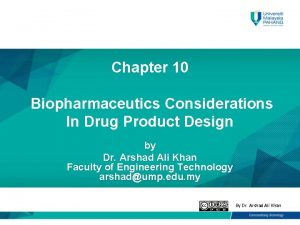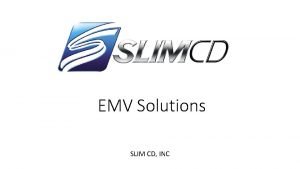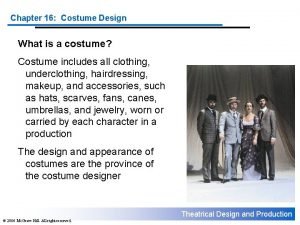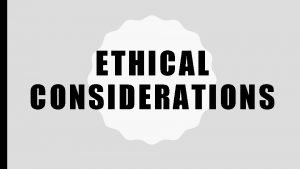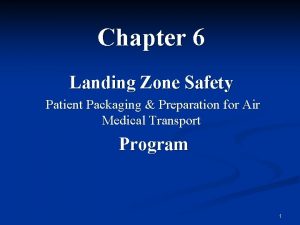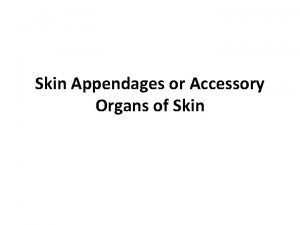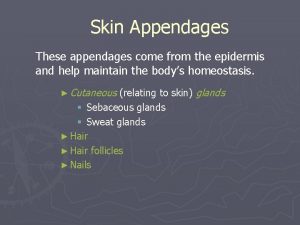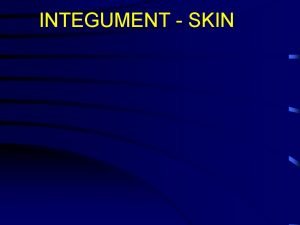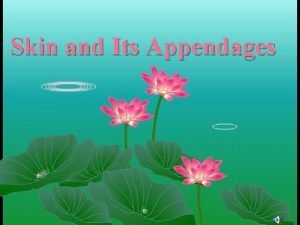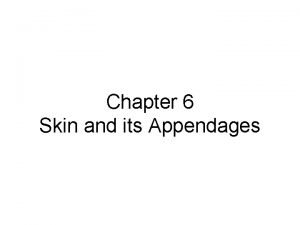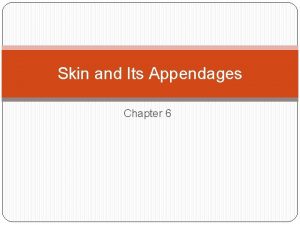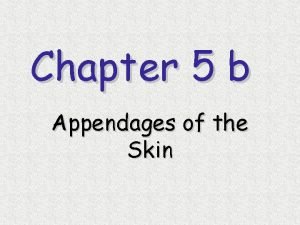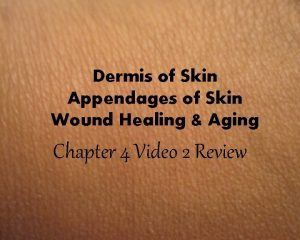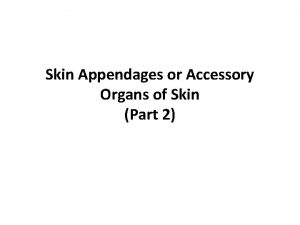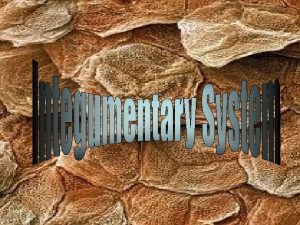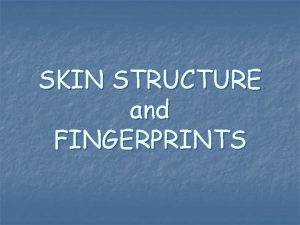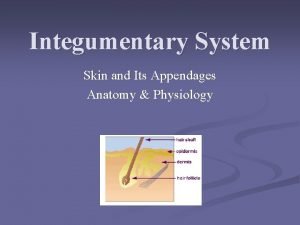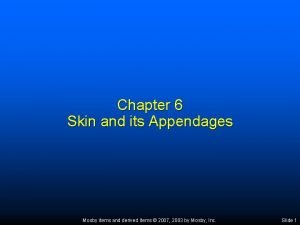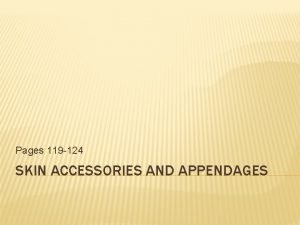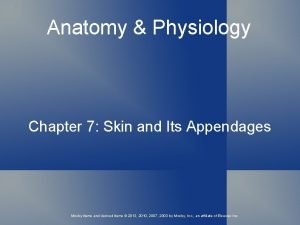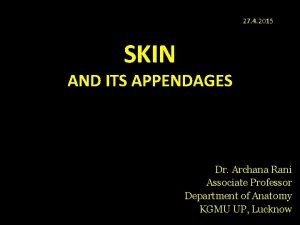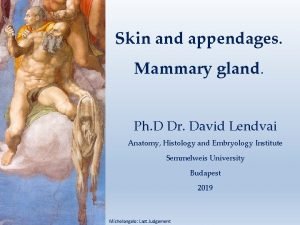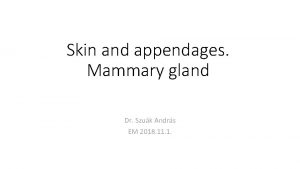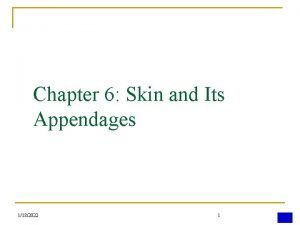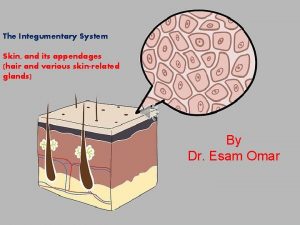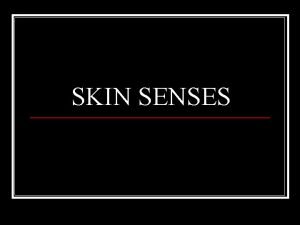Skin Appendages I General Concepts and Considerations A











































- Slides: 43

Skin & Appendages I. General Concepts and Considerations

A. Heaviest single organ of body 1. 16% of total body weight 2. 1. 2 - 2. 3 m 2 surface area Epidermis Dermis Hypodermis

C. Functions of the skin 1. 2. 3. 4. 5. 6. 7. Protection from injury, desiccation, infection Regulation of body temperature Absorption of UV radiation for synthesis of vitamin D Reception of sensory stimuli Secretion of protective lipids, milk Dermis and epidermis interdigitate via dermal papillae - best developed in areas exposed to shearing stress Classified as thick or thin depending on the thickness of epidermis

Skin & Appendages II. Epidermis

A. Characteristics 1. Keratinized stratified squamous epithelium Regenerated by keratinocytes Formed by five layers or strata 2. 3. a. b. 4. turnover from basal to superficial varies from site to site 25 -30 days fastest; 40 -50 days slowest Downgrowths produce sweat glands and hair follicles

Epidermis

B. Stratum Basale 1. 2. 3. Deepest layer, attached to basement membrane by hemidesmosomes Keratinocytes, large euchromatic nuclei, mitotically active Melanocytes and Merkel cells

C. Stratum Spinosum 1. 2. 3. 4. 5. 6. 7. A few layers of prickly keratinocytes Intercellular bridges formed by desmosomes Round, euchromatic nuclei, mitotically active Concentrated tonofilaments in cytoplasm Upper cells cemented together to waterproof the skin Langerhans cells & cytoplasmic projections of melanocytes Psoriasis

D. Stratum Granulosum 1. 2. 3. 4. Cells accumulate keratohyalin granules and bundles of intermediate keratin filaments All cells produce membrane-coated granules Keratohyalin granules composed of histidine- & cystinerich proteins that glue keratin filaments together Nuclei are present

E. Stratum Lucidum 1. Clear homogenous layer 2. Nuclei and organelles are not present 3. Cells contain eleidin

F. Stratum Corneum – Thick Skin 1. Outermost layer, formed of dead cells 2. Surface cells continuously desquamated

F. Stratum Corneum – Thin Skin

G. Other cellular components 1. Melanocytes 2. Langerhans cells 3. Merkel's cells Langerhans Cell Melanocytes

1. Melanocytes a. b. c. d. e. f. g. h. structure derivation melanosomes keratinocytes skin color distribution races tanning

1. Melanocytes

2. Langerhans cells a. b. c. d. e. dendritic-shaped cells derived from the bone marrow present in all layers but mainly in stratum spinosum ovid, pale-staining nuclei, cytoplasm with granules, processes function as APCs increase in number in chronic inflammatory skin diseases

3. Merkel's cells 1. 2. 3. 4. found in thick skin; scanty and difficult to find in thin skin present in stratum basale contain small dense-core granules receive afferent nerve terminals, believed to function as sensory mechanoreceptors

H. Types of Skin

H. Types of Skin Thin Skin Thick Skin Covers entire body except palms and soles (0. 5 mm on the eyelid, 5 mm on the back) Thin epidermis, dermis can be thick Hair follicles with sebaceous glands Sweat glands On palms and soles of the feet (0. 8 mm to 1. 5 mm thick) Thick epidermis Hairless thus no sebaceous glands Sweat glands Epidermis

Skin & Appendages III. Dermis

A. Characteristics 1. 2. 3. 4. Dense irreg. FECT Contents Aging Blood vessels

Epidermal-Dermal Junction § Scalloped margin consisting of epidermal pegs and dermal papillae § Strengthens attachment of epidermis to the underlying dermis Epidermal peg Dermal papilla 400 X 40 X

Dermis

Blood Vessels of Dermis

B. Layers 1. Papillary Layer - loose FECT that forms the dermal papillae, loops of small blood vessels and capillaries, nerve endings

B. Layers 2. Reticular Layer - dense irregular FECT that forms bulk of dermis, with blood vessels and a-v shunts, lymphatics and nerves

B. Layers 3. Erector Pili Muscle a. bundles of smooth muscle, attached to hair follicles in dermis and papillary layer of dermis b. contraction elevates hairs (makes them more vertical) and produces goose bumps

3. Erector Pili Muscle

C. Nerve Supply 1. 2. 3. 4. 5. Sympathetic NS Afferent fibers Free nerve endings Pacinian Corpuscles Meissner's Corpuscles

Paccinian Corpuscle

Meisner’s Corpuscle

D. Blisters

E. Dermatitis

Wound Repair

Skin & Appendages IV. Glands

A. Eccrine sweat glands 1. 2. 3. 4. 5. 6. 7. 8. Characteristics Dark cells Clear cells Myoepithelial cells Ducts Dermis & epidermis Produce sweat Sweat

B. Apocrine Sweat Glands Hair follicle Sebaceous gland § In axillary, areolar & anal regions § Viscous secretion § Empty into hair follicles Sebaceous gland

C. Sebaceous Glands 1. Holocrine gland 2. Hair follicle 3. Non-hair 4. Activity 5. Sebum 6. Number & size 7. Locations 8. Absent 9. Acne

C. Sebaceous Glands

Skin & Appendages V. Appendages

A. Hair 1. Derived from epidermal epithelium 2. Locations 3. Medulla, cortex, & cuticle 4. Root of hair, hair bulb, dermal papilla 5. Rate of growth 6. Hair color due to melanin

B. Nails 1. Location 2. Nail plate & nail bed 3. Eponychium (cuticle) 4. Hyponychium 5. Growth

B. Nails
 General consideration of machine design
General consideration of machine design Skin information
Skin information Thin skin vs thick skin
Thin skin vs thick skin Milady basic facial steps
Milady basic facial steps Introduction to arthropods
Introduction to arthropods Arthropods structure
Arthropods structure Takeair
Takeair Whip like flagella
Whip like flagella Arthropods segmented bodies
Arthropods segmented bodies Sensory appendages
Sensory appendages Writing strategies and ethical considerations
Writing strategies and ethical considerations Experimental design and ethical considerations
Experimental design and ethical considerations Pricing considerations and approaches
Pricing considerations and approaches Chapter 8 bonding general concepts answers
Chapter 8 bonding general concepts answers Tax considerations for setting up a new business
Tax considerations for setting up a new business Atm kiosk solution
Atm kiosk solution Three considerations of societal marketing concept
Three considerations of societal marketing concept Mechanical considerations of transmission line
Mechanical considerations of transmission line Database design considerations
Database design considerations Contrasting acquisition
Contrasting acquisition What is cloud delivery model
What is cloud delivery model Pre analytical considerations in phlebotomy
Pre analytical considerations in phlebotomy Bioreactor considerations for animal cell culture
Bioreactor considerations for animal cell culture Collaboration design considerations
Collaboration design considerations Principle of tooth preparation
Principle of tooth preparation Anatomical considerations
Anatomical considerations Biopharmaceutic considerations in drug product design
Biopharmaceutic considerations in drug product design Retromylohyoid fossa classification
Retromylohyoid fossa classification Spa y dogso
Spa y dogso Design considerations icons
Design considerations icons Climatic conditions pdhpe
Climatic conditions pdhpe Gastrectomy anesthesia considerations
Gastrectomy anesthesia considerations Capk file expired
Capk file expired Design considerations for mobile computing
Design considerations for mobile computing Qualitative research design
Qualitative research design Venturi mask 50 percent
Venturi mask 50 percent Ethical considerations examples
Ethical considerations examples Considerations examples
Considerations examples Web security considerations
Web security considerations Types of costume design
Types of costume design Hach wims
Hach wims Ethical considerations in research example
Ethical considerations in research example Azure landing zone considerations
Azure landing zone considerations Data warehouse considerations
Data warehouse considerations




